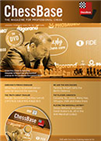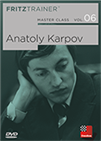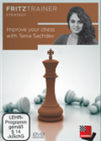Rook vs Minor Piece endgames, a review
What's the best gift for a chess player? A non chess player would have difficulties answering such question. There are so many choices on the market: new chess books hit the shelves every month, new chess DVDs are published on every possible opening, new boards and chess sets (recently I even got a new DGT Centaur).
However, I'm becoming passionate about endgames, and in the process I realized they do improve my results. In fact in my last blitz match, my usual opponent improved a lot, and I felt I couldn't overwhelm him for opening prep or middlegame, but the endgame was really what made the difference.
Endgames are fundamental in chess improvement, especially in the modern landscape of chess tournaments, where the time controls are becoming shorter and shorter.
Now, don't get me wrong, I do study openings all year long, because I believe there are so many things I don't know so many ideas to grasp. I play in many tournaments, so I do need to vary my opening repertoire, to avoid the preparation of opponents which I usually meet in local tournaments. But from the beginning of last year, every time I downloaded the new ChessBase Magazine, I began by reading the column authored by Karsten Mueller.

Throughout last year my usual problems — mistakes in calculation, or wrong evaluation of some positions — didn't disappear, and they landed me in some very bad situations, but guess what happened. When I was approaching the endgame my antennas would come out, and surprisingly I began to imagine fortresses, activation of rooks, triangulations, and other common endgame ideas which would allow me to draw the game. Yes, I saved a lot of half points thanks to lessons from Mueller, through the pages of his books, or the examples he shows regularly on ChessBase Magazine — grandmaster wisdom from the other side of the Atlantic!
 Analyses by Caruana, Giri, Duda, Wang Hao, So, Vidit, Vitiugov, McShane and many more. Plus videos by Williams, King and Shirov. 11 opening articles with new repertoire ideas and training sessions in strategy, tactics and endgame!
Analyses by Caruana, Giri, Duda, Wang Hao, So, Vidit, Vitiugov, McShane and many more. Plus videos by Williams, King and Shirov. 11 opening articles with new repertoire ideas and training sessions in strategy, tactics and endgame!This said, I thought the best gift I could give myself (valid for any season), was another book by Mueller, because I want to continue my chess improvement, and I believe Mueller is the key to make it happen. To be honest, I'm unlikely to read an entire book, because I have family, work, a young son who wants to play with me, but I generally get about 10-15 positions for each chapter, and try to study them, practice them, and of course understand the concepts Mueller conveys. I also follow one piece of advice given to me by a long time coach — Ben Vinyard — who told me to do 30 minutes of endgame study first thing in the morning every day.
For a quick overview of the book: it has nine chapters. The first chapter is dedicated to rook vs knight endgames, but it begins with pawnless endgames. Here the rule says if the knight can be separated by the king, generally the rook side wins. But does it actually happen in practical games? Well it happened to me, and thanks to knowing this rule explained on page 15 by Mueller I was able to draw the game against a local National Master!
In the following position I'm lost:
Just seven moves later I'm into a knight vs rook endgame which ended in a draw after 50 more moves, because my opponent, rated over 2200, didn't believe I could draw it.
Try to play against the computer above. In Mueller's book there is a wealth of positions which explain the dos and don'ts of this endgame. The one I loved most from Chapter 1 is the one called: 'Karpov distance', because in Mueller's words: "Karpov was a real expert in knight hunting". Here the entire game, one can begin to follow the endgame, and annotations from move 84.
 On this DVD a team of experts looks closely at the secrets of Karpov's games. In more than 7 hours of video, the authors examine four essential aspects of Karpov's superb play.
On this DVD a team of experts looks closely at the secrets of Karpov's games. In more than 7 hours of video, the authors examine four essential aspects of Karpov's superb play.Often we follow the explanations, read all the variants, and agree intellectually with the author, but then when we try to replicate such knowledge we fail. A good way is to practice against a sparring partner like Fritz. Here with the above position, try to win against the engine!
Many useful exercises close out the first chapter.
Chapter 2 is about Rook vs Bishop endgames and, like the first, it begins with pawnless endgames. I found the first example taken from the game Sachdev vs Schut quite important and worth the time to learn. The annotations by Mueller alone make the price of the book worth it — it's like getting a lesson from a GM, on a particular endgame trick/technique worth knowing!
 On this DVD, well-known Indian WGM Tania Sachdev shows you how to evaluate certain positions and then find the right concepts and plans on the basis of her own games.
On this DVD, well-known Indian WGM Tania Sachdev shows you how to evaluate certain positions and then find the right concepts and plans on the basis of her own games.Just to reiterate the point: Mueller shows ways Black could have saved the game, and ways White could have gone on the wrong path giving Black another chance. This is quite important, because often during a game we are too focused on what we can do, and discount what our opponent best choice could be.
Chapter 3 is about rook vs 2 knights or 2 knights versus pawn/s and rook. Crazily enough, I've seen games between some of my young students which ended with some of the Troitzky endgame positions mentioned in this chapter. In the chapter there are also some excellent names whose games had these kind of endings like: Nakamura, Carlsen, Timman — just to mention few which caught my eye.
Chapter 4: Rook vs two bishops. While watching many of these endgames, not necessarily trying to solve them, helps one to better understand how to be active in the endgame, and avoid passive pieces. And this is definitely the lesson from this chapter. The bishops need to be active in order to win the endgame.
 Let endgame expert Dr Karsten Müller show and explain the finesses of the world champions. Although they had different styles each and every one of them played the endgame exceptionally well, so take the opportunity to enjoy and learn from some of the best endgames in the history of chess.
Let endgame expert Dr Karsten Müller show and explain the finesses of the world champions. Although they had different styles each and every one of them played the endgame exceptionally well, so take the opportunity to enjoy and learn from some of the best endgames in the history of chess.Chapter 5: Rook vs bishop and knight endgames. I like to show some positions, because I firmly believe a review or an article must be something which interact with the reader, and since now I'm part of a great group of chess coaches, it can help them with finding material for their lessons, since they can use the article as platform for teaching their students.
Mueller selected positions from many different sources. The following comes from a correspondence game, and I found it strange that White having the time to analyze didn't find the correct move.
For example in this position if White would have found the right idea, he could have drawn the game.
But unfortunately White played 52.♘e5? and lost the game. Here the entire game, with the important comments from move 51, and the correct move to enforce a blockade:
Chapter 6: Another important reason to have a book like this one is to be exposed to the material. We are humans not computers, but some of the ideas and maneuvers shown by Mueller in this book can stick in our chess minds. Hence the need to have a book like this one, and from time to time, when we are in the mood to open it, and enjoy one or two positions. The theme of this chapter is rook + knight vs rook.
 This DVD allows you to learn from the example of one of the best players in the history of chess and from the explanations of the authors (Pelletier, Marin, Müller and Reeh) how to successfully organise your games strategically, consequently how to keep y
This DVD allows you to learn from the example of one of the best players in the history of chess and from the explanations of the authors (Pelletier, Marin, Müller and Reeh) how to successfully organise your games strategically, consequently how to keep yI found a very beautiful endgame in which the legendary Vladimir Kramnik missed a win. Try to play it against the engine, and see if you can do better!
The critical move is the 62nd, and if one doesn't want to play it against the engine, I've placed the whole game, with the lines shown in the book. However Mueller in the book goes into more detail, and also comments on other part of this endgame.
Chapter 7: This chapter treats rook + bishop vs rook. There are some interesting concepts, like the Cochrane defense, or the second rank defense, which are fundamental knowledge for every chess player. But there are also ways to win which go back as far as Philidor. Clearly a chapter everyone should read!
Chapter 8: In this chapter there are interesting positions which show how the presence of a minor piece can alter the result of the game. Mueller shows endgames which one could wrongly label as middlegames, and shows what changes based on presence and absence of some pieces, and how one should think about them. These last two chapters definitely stirred my interest, because I noticed many players don't project well enough in which type of endgame they will enter. The consequence is that they don't know what the result will be.
Chapter 9 will be favored by many. GM Alonso Zapata, who works in the same teaching company as I do, is definitely convinced studies are the way to go in order to learn and improve one's own chess. This chapter is just made up of just two pages, with eight studies.
The chapters in numbers
Chapter 1: 46 positions, 28 exercises
Chapter 2: 77 positions, 28 exercises
Chapter 3: 17 positions, 2 exercises (you don't want exercises from this chapter, your head could explode!)
Chapter 4: 20 positions, 7 exercises (in this chapter there are wins in 150-170 moves, one should learn them if under 10 years old, definitely not for seniors!)
Chapter 5: 36 positions, 9 exercises
Chapter 6: 10 positions, 6 exercises
Chapter 7: 15 positions, 4 exercises
Chapter 8: 15 positions, 17 exercises
Chapter 9: 8 endgame studies.
Pro and Con
I like that all the games are mentioned, allowing me to check the entire game, and create a database of games which have important endgames. Such games can be watched from time to time to refresh one's own knowledge.
In Chapter 4 there was something missing. On page 124 there appears the game Maiorov vs Onischuk 2007 (as 04.01) then there is another diagram which is not marked and shows another game (which I believe is 04.02) but we are missing the end of 04.01. I guess something happened during the editing of the pages and the printing.

Mistakes happen
But here is the point which makes me happy and why I believe we live in very exciting times. I contacted the author, showed him my findings, and he immediately sent me the correction through a ChessBase file, which I'm sharing in this review!!
With the Internet, the fact now we are all connected, we can have positive interactions like this, working together!
But there is also another side to this story. When I was little I collected stamps, and one of these stamps was called "Gronchi Rosa" (Pink Gronchi, the noun is the Italian last name of a President.) While it's face value was just few cents, the real value in the booming economy of the 80s, was something like 500 dollars. Why? Because there was a mistake! Now this book will soon be corrected by a new edition, but I will still own the "Black Karsten" which will be more valuable than the corrected book. Thanks to this editing mistake, I own something unique, and this is quite valuable for every chess book collectors!

I couldn't even finish writing this review, which I received a new "edition" of this book which is corrected, it doesn't have the printing blunder at pages 124-125, making the first edition of the book, as I just mentioned, much more valuable! My friend Thad Rogers, long time tournament organizer and chess books seller from a long time still has some of the books with the mistakes on page 124-125, that he's selling for a special price!
(Thad loves this book written by GM Romain Edouard, and he's selling also the latest version of Fritz, Fritz 17.)
I try to use books like this one for improving my visualization. Yes, I don't always try to see the solution of the positions on the board, I try to follow the moves visualizing the board in my head. There are many reasons, but mainly it's because I'm always focused on trying to improve my chess. Maybe the book could benefit from a higher number of diagrams, since some solutions are quite long (50 moves), and become simply impossible to visualize them, without using a board — even with a board it can become easy to miss a move and become confused.
Final thoughts
Throughout the book I've seen some of the best names in chess: Karpov, Ding, Karjakin, Grischuk etc. playing endgame after endgame. The reason is obvious: when one becomes a good player there are no mistakes in the opening, or huge blunders in the middlegame, and often it comes to a small advantage one inherited from the middlegame, which needs to be converted into a victory in the endgame. Often a draw thanks to endgame knowledge feels like a win, and we can see it in our opponent's faces how disappointed they are. Last year I gained over 100 points, and this year began with nearly 20 points gain. I believe studying the endgame has been one essential component for such improvement.

Davide Nastasio with his new DGT Centaur board
Links


























